Ethanol production is based mainly on two basic processes regardless of the feedstock, which include the fermentation of a sugar-rich substrate followed by the distillation of the fermented solution.
Feedstock processing steps may differ according to the ready availability of reducing sugars, that is, the broth extracted from sugar-rich crops, such as sugarcane, beet, and sweet sorghum, may be directed employed in fermentation, whereas starch-rich (e.g., corn, cassava, and barley) and cellulosic materials require pretreatment steps
Ethanol production from sugar-rich feedstocks may be conducted using directly the sugars extracted from sugarcane (juice)—autonomous distilleries—or blends between the juice and molasses, a sucrose-rich concentrated residual solution from sugar production (Fig. 5.1). In this case, distilleries are named annexed plants, which constitute most of ethanol plants in Brazil (~ 70%, Cavalett et al., 2012).
Molasses may also be employed directly in ethanol production, such as in the Indian sugarcane-to-ethanol industry, where juice is used solely in sugar refining (Soam et al., 2015). Nevertheless, regardless of the feedstock and process characteristics, vinasse is generated specifically within the distillation step (Fig. 5.1), presenting some interesting compositional aspects in terms of biodegradable organic matter.
Fig. 5.1. Technological routes for ethanol production from different feedstocks. Note: aIncludes the application of different physical-chemical and/or biological processes to disrupt vegetal fibers found in lignocellulosic materials, converting polysaccharides into fermentable sugars (Moraes et al., 2015).
Compositional characteristics for vinasses from different feedstocks are compiled in Table 5.1, usually indicating high values (> 0.4) for the ratio between the biochemical (BOD) and chemical (COD) oxygen demands, that is, BOD/COD ratio, regardless of the feedstock. This relation roughly describes the suitability of a given wastewater to biological process treatments, so that for values higher than 0.3–0.4, the biodegradable fraction may be considered high (von Sperling, 2007). Biodegradable organic compounds in vinasses result mainly from three sources:
(i) residual fractions of nonconverted sugars, (ii) residual concentrations of nonrecovered ethanol, and (iii) fermentation of by-products, that is, metabolites excreted by yeasts and contaminant microorganisms, such as glycerol and organic acids (Wilkie et al., 2000; Dias et al., 2012). According to Wilkie et al. (2000), every 1% of residual reducing sugars and ethanol may lead, respectively, to increments of about 16 and 20 gL− 1 in the COD of vinasse. Since such compounds are easily assimilated in anaerobic environments, the application of AD to vinasse theoretically enables obtaining high biogas production rates as a direct result from an efficient conversion of the organic matter
Integrated hydrolysis, fermentation and co-fermentation of lignocellulosic biomass
The simulated process includes the enzymatic hydrolysis of sugarcane bagasse pretreated with liquid hot water, and the analyzed parameters were the solid consistency in the hydrolysis and pretreatment reactors and the hydrolysis reaction time. The solid consistency in the hydrolysis reactor had the highest influence on the economic feasibility of the process. For the economic scenario considered in this study, using bagasse to increase ethanol production yielded higher ethanol production costs compared to using bagasse for electric energy production, showing that further improvements in the process are still necessary.


